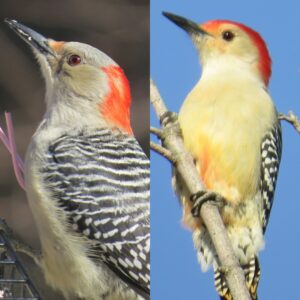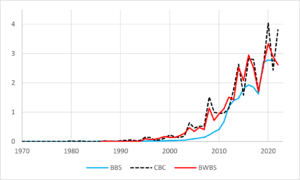(Story and photos by Pam Hunt)

The Red-bellied Woodpecker (Melanerpes carolinus) is a perennial candidate for “most poorly named species,” given that the far more prominent red feature is the crown and nape. If you see one up close, however, there is a red wash to the belly. One can only assume that the appellation “Red-headed” was already taken by the other woodpecker with that name, and in which the entire head is red. The Red-headed Woodpecker is quite rare in New Hampshire, and almost all reports turn out to be Red-bellies.
Name issues aside, the Red-bellied Woodpecker is a very recent colonist to New Hampshire. It was quite rare prior to 2000, but since then expanded across the state south of the White Mountains. In the 2020s it began to show up in small numbers north of the notches. Even in the south, numbers are still highest in the larger river valleys and seacoast areas, and it avoids (so far) forests dominated by conifers. The species’ arrival here is simply the most recent stage of an expansion that’s been going on since the start of the 20th century. The reasons for the northward (and westward) expansion aren’t well understood, but tend to consider factors including reforestation, increases in feeders, and climate change. It has also been proposed that the loss of elms to Dutch elm disease from the 1940s onward helped this species by providing more dead trees for nest sites.

New insect pests of trees are probably still helping Red-bellied Woodpeckers. A recent study showed that several woodpecker species increased in the wake of the spread of emerald ash borer (an invasive beetle) from 2002-2016. Although the beetle didn’t get to New Hampshire until 2013, it is likely that woodpeckers from deeper into the infestation were dispersing this way prior to that and finding conditions here suitable for nesting. Woodpecker responses to ash borers were stronger in winter than in summer data, suggesting that the availability of the beetle larvae at that time was important for overwinter foraging.
But Red-bellies eat a lot more than wood-boring insects, and in fact spend less time excavating prey from wood or bark than most other New Hampshire woodpeckers (the exception being the flicker). In fact, insects in general make up less than half its diet. The remainder is composed of fruit, nuts, and seeds, with lesser amounts of nectar and small vertebrates (lizards, tree frogs, nestling birds). At feeders, Red-bellies are often attracted to oranges much as are orioles.
State of the Birds at a Glance:
- Habitat: Hardwood/Mixed Forest, Developed Areas
- Migration: Non-migratory
- Population trend: Strongly increasing
- Threats: None identified
- Conservation actions: Maintain a bird-friendly yard (keep cats indoors, minimize collisions)
More information on “The State of New Hampshire’s Birds” is available here.
